非限制性定语从句课件
合集下载
非限制性定语从句语法公开课ppt课件
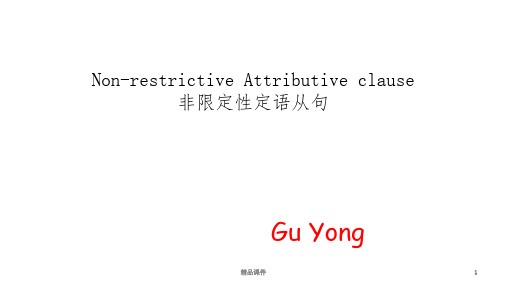
Whose hair is thick and long
With which I pass the time
The night when I was back to the The road I look back many times
town The river The tears
which which
that / 2.There is a schoolw__h_ic__hlies in the east of Shangluo, w__h_o_s__e
name is Shangdan,w__h_ic_h__ good teachers and hard-working students come to, _w_h_o__ are to creat a colourful victory. 商洛的东方有个学校,他的名字叫商丹,教坛精英八方至, 莘莘学子如潮涌,我们要创造最绚丽的辉煌。
辫子粗又长
The night_w_h_e_n_ I was back to the town 在回城之前的那个晚上
The river _w_h_i_c_h_ you and me came to 你和我来到小河旁
The tears w__h_ic__h I never shed(流泪) 从没流过的泪水
精品课件
12
Polishing the passage
I have a good friend.She is my classmate,her name is Tracy.She is a pretty girl. She studies in Yulin No.2 Middle school.She is in Class 1,Grade 1.She studies hard all day.And she can speaks English very well.So she often help my English. I thank her help. And I help her math, too. Because my math is very good. We learn from each other and help each other.
非限定性定语从句课件

The social revolution has no parallel in history. in parallel with与…同时; 和…一起; 并行
The private organization works in parallel with the state education system.
这是我第一次来北京。 It is the first time that I have come to Beijing.
辨析: the first time与for the first time
the first time (作n. 或conj.) “当第一次做…时” for the first time (介词短语作状语) “作为第一次”
10. keep sth up 继续; 不落后; 保持 Keep up the good work.继续好好干. Slow down.. Dancy can’t keep up. 放慢速度 ,Dancy跟不上了. Keep up a good mood. Keep up your spirits 保持好心情. keep up with跟上 I have some trouble keeping up with the rest of my classmates. 11. fit in (with sb/sth) 与…相适应; 和…相处融洽 At first I felt awkward, but soon I learned to fit in. Larry doesn’t seem to fit in with other children.
我们的损失使我担心起来。
习惯用法:
show concern for sb.
关心某人
The private organization works in parallel with the state education system.
这是我第一次来北京。 It is the first time that I have come to Beijing.
辨析: the first time与for the first time
the first time (作n. 或conj.) “当第一次做…时” for the first time (介词短语作状语) “作为第一次”
10. keep sth up 继续; 不落后; 保持 Keep up the good work.继续好好干. Slow down.. Dancy can’t keep up. 放慢速度 ,Dancy跟不上了. Keep up a good mood. Keep up your spirits 保持好心情. keep up with跟上 I have some trouble keeping up with the rest of my classmates. 11. fit in (with sb/sth) 与…相适应; 和…相处融洽 At first I felt awkward, but soon I learned to fit in. Larry doesn’t seem to fit in with other children.
我们的损失使我担心起来。
习惯用法:
show concern for sb.
关心某人
限定性定语从句与非限定性定语从句的区别-全ppt课件.ppt

______ they lend you an umbrella in fair weather and ask for it back when it begins to rain. A. when B. that C. where D. there
A .含有be 动词 He failed the exam, as is natural.
B.实意动词的被动形式
As is reported, the fire caused a great loss.
C. 感官动词和意识类动词 如:see, hear, notice, know, learn,realize 等
and flo_ww_h_e_yr_s;ha作d地be点en状p语la时n用ted_w.__h_e_r_e_; 9. This is作th时e 间isl状an语d时_w_,h_用_er__we__h_Ie_ln_i_v。ed for two
years.
10. 2001-2005 are the years _w_h_e_n_ I studied in the university.
6. Is it the reason _w__h_y_ you were late? 7. October 1st is the date _w_h_e_n_ China
celebrat关es系its副N词a在tio定na语l 从Da句y.中代替先行 8. We wal词ke做d状in语a。ga先rd行e词n _作w_原_h_e因_re_状m语a时ny用trees
A. for which B. with which
C. of which
D. to which
7. (2011江苏卷) Between the two parts of the concert is an interval, _______ the audience can buy ice-cream.
A .含有be 动词 He failed the exam, as is natural.
B.实意动词的被动形式
As is reported, the fire caused a great loss.
C. 感官动词和意识类动词 如:see, hear, notice, know, learn,realize 等
and flo_ww_h_e_yr_s;ha作d地be点en状p语la时n用ted_w.__h_e_r_e_; 9. This is作th时e 间isl状an语d时_w_,h_用_er__we__h_Ie_ln_i_v。ed for two
years.
10. 2001-2005 are the years _w_h_e_n_ I studied in the university.
6. Is it the reason _w__h_y_ you were late? 7. October 1st is the date _w_h_e_n_ China
celebrat关es系its副N词a在tio定na语l 从Da句y.中代替先行 8. We wal词ke做d状in语a。ga先rd行e词n _作w_原_h_e因_re_状m语a时ny用trees
A. for which B. with which
C. of which
D. to which
7. (2011江苏卷) Between the two parts of the concert is an interval, _______ the audience can buy ice-cream.
非限制性定语从句公开课件

实际应用场景
在描述某个人、事物或概念时, 可以使用非限制性定语从句来补 充相关信息,使句子更加完整。
在解释某个概念或术语时,可以 使用非限制性定语从句来提供更 多背景信息,帮助读者更好地理
解。
在描述某个事件或情况时,可以 使用非限制性定语从句来提供更 多细节,使句子更加生动有趣。
04
非限制性定语从句的练习与巩固
遗漏逗号分隔
非限制性定语从句与主句之间通常用逗号分隔,如果遗漏逗号,可 能会造成句意混淆。
语序不当
非限制性定语从句的语序应与主句保持一致,否则可能导致句意不 清晰。
经典例句解析
The book, which was written by a famous author, was highly recommended.(这本书是由一位著 名作家所写,受到了高度推荐。)
内容
限制性定语从句用于限定或识别先行 词的身份或属性,不可省略;而非限 制性定语从句则是附加说明先行词, 可以省略不影响主句意义。
02
非限制性定语从句的用法
引导词的选择
关系代词
which、who、whom、whose等。
关系副词
when、where、why等。
复合关系代词
what、whatever、whoever、whomever等。
从句的功能
01
02
03
补充说明
非限制性定语从句可以用 来补充说明先行词的某些 信息,使句子更加完整。
强调先行词
非限制性定语从句可以用 来强调先行词,突出其重 要特征。
转折关系
非限制性定语从句也可以 用来表示转折关系,与主 句形成对比。
注意事项
避免冗余
非限制性定语从句中的信 息应该是必要的,避免重 复和冗余。
非限制性定语从句(46张PPT)
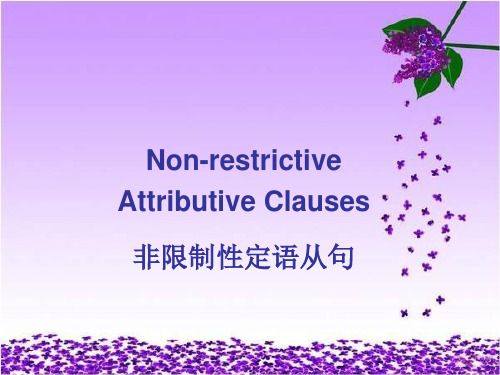
I’m seeing the manager tomorrow, when he will be back from Shanghai.
限制性&非限制性定语从句比较
限制性
非限制性
与先行词的关系
紧密, 删除后影 松散, 只是补充 响意思表达 说明
逗号
无
有
连接词
所有都可用 一定不能用that
连接词能否省略 作宾语时可省 绝不能省略
differently.
A. all of which B. each of which
C. all of them
D. each of them
4. (2014重庆) We’ll reach the sales targets in a
month ________ we set at the beginning of the
他似乎没理解我的意思,这使我心烦。
Liquid water changes to vapor, which is called evaporation.
液态水变为蒸汽,这就叫做蒸发。
Complete the following sentences.
1. They got married in September. I was then in the countryside.
2. The house, which we bought last month, is very nice.
3. Charles Smith, who was my former teacher, retired last year.
4. This novel, which I have read three times, is very touching.
限制性&非限制性定语从句比较
限制性
非限制性
与先行词的关系
紧密, 删除后影 松散, 只是补充 响意思表达 说明
逗号
无
有
连接词
所有都可用 一定不能用that
连接词能否省略 作宾语时可省 绝不能省略
differently.
A. all of which B. each of which
C. all of them
D. each of them
4. (2014重庆) We’ll reach the sales targets in a
month ________ we set at the beginning of the
他似乎没理解我的意思,这使我心烦。
Liquid water changes to vapor, which is called evaporation.
液态水变为蒸汽,这就叫做蒸发。
Complete the following sentences.
1. They got married in September. I was then in the countryside.
2. The house, which we bought last month, is very nice.
3. Charles Smith, who was my former teacher, retired last year.
4. This novel, which I have read three times, is very touching.
高中英语语法讲解PPT课件:非限制性定语从句 教学课件(共26张PPT)
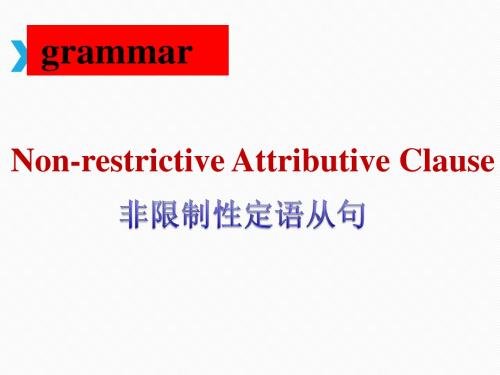
1. My house, garden.
_______w__h__icIhbought
last
year,
has
a
beautiful
2.The girls, ________ the teachers speak highly of, is our monitor.
whom
.
非限制性定语从句不能_省__略___关系代词。关系代词在非限制性 定语从句中作宾语时, 指人只能用_w__h_o_m__不能用__w__h_o
2.Our head teacher is searching for the evidence w__h_ic_h__/ t_h_a_t shows the students are using phone.
3.Peter , _w__h_o__ is quiet in class, studies very hard. 4.The Great Wall is a cultural relic, _w__h_ic_h__ is worth visiting.
Summary of the differences:
•form •antecedent •relative words •Meaning
错漏“摆”出 1. People are excited to meet Zhai Zhigang, he
was the first Chinese to walk in space . who
Compare:
1. He was late, which made the teacher very angry. antecedent: __h_e_w__a_s_l_a_te__ ,__A_s_e_n_t_e_n_ce •
非限制性定语从句完整版ppt课件

cultural relics in the old days.
(5) They moved the boxes to a mine, where _____
they wanted to hide them.
Task 2: Practice.
(1) What surprised me was not what he said but the way _____________ (that/in which) he said it. (2) We’re just trying to reach a point _____ both sides will sit down where together and talk. (06山东)
As “正如、像……一样” 位置可放在主句前面,也可放 在后面。而which引导的非限制性定语从句只能放在主句 之后,且无“正如”之意。
试比较下面两个句子。
as He went abroad, __________was expected.
which He went abroad, __________was unexpected. 当从句是否定句或表示否定意义时,只能用which引导。
(She has only two brothers.)
下面两个句子只有一个逗号之差, 意义大相径庭。
a)He will wear no clothes which will make him
different from others.
他不会穿一些使他显得与众不同的衣服。
b) He will wear no clothes, which will make him different from others. 他不穿衣服, 这会使他显得与众不同。
超实用高考英语非限制性定语从句课件

从。 4. 介词+which / whom引导的非限制性定语从句。 5. 名词/ 代词+ of + which / whom 引导的非限制性定语从句。
温馨提醒
Try your best to use the grammar structures in your later writing, but
• as we expected / as is expected, ……
• as the saying goes, …
众所周知,… 就如你所见 / 正如你所想的,… …这是常有的事 如上所述,… 正如我们所预料的,… 正如这句名言所说,…
1. _A_s__is__o_ft_e_n_t_h_e_c_a_s_e, he was absent from the class.
4. Guangzhou , _w_h_e_r_e_ the Asian Games will be held , lies in the south of
China.
when
5. The president paid a visit to the city last week , _______ there was a strike
theAres.
6. ____ we all know, he is the first to come and the last to leave .
as: 正如;正像...一样 as we all know = as is known to us all, as is mentioned above, as is hoped,
__h_a_s_a_b_a_d__in_f_l_u_e_n_ce__o_n_t_h_e_i_m_a_g_e__o_f _th_e__s_ch_o_o_l__________. 3. (邀请信) A lot of calligraphy works of famous artists will be
温馨提醒
Try your best to use the grammar structures in your later writing, but
• as we expected / as is expected, ……
• as the saying goes, …
众所周知,… 就如你所见 / 正如你所想的,… …这是常有的事 如上所述,… 正如我们所预料的,… 正如这句名言所说,…
1. _A_s__is__o_ft_e_n_t_h_e_c_a_s_e, he was absent from the class.
4. Guangzhou , _w_h_e_r_e_ the Asian Games will be held , lies in the south of
China.
when
5. The president paid a visit to the city last week , _______ there was a strike
theAres.
6. ____ we all know, he is the first to come and the last to leave .
as: 正如;正像...一样 as we all know = as is known to us all, as is mentioned above, as is hoped,
__h_a_s_a_b_a_d__in_f_l_u_e_n_ce__o_n_t_h_e_i_m_a_g_e__o_f _th_e__s_ch_o_o_l__________. 3. (邀请信) A lot of calligraphy works of famous artists will be
高一非限制性定语从句公开课PPT课件
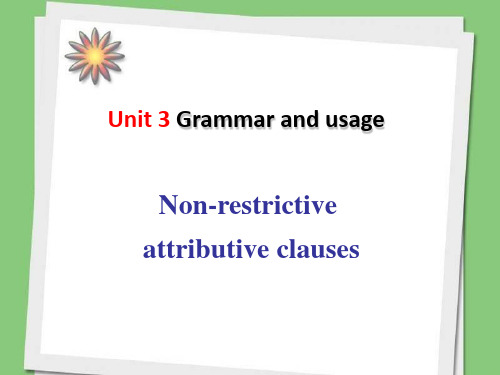
Think it over
只用which 的情况?
1、介词提前,且先行词指事或物; 2、在 all/ some/ one/ both/ neither/ none/ most…+of _________结构中, 且先行词指事或物; 3、非限制性定语从句先行词指物 且从句中需要代词做主语、宾语和 表语时。
Luckily,she is recovering and she is willing to follow the doctor’s advice,__w_h_i_c_hmakes all of us
happy .
指代人 who, whom, that, as 关
归 纳
指代事物 which, that, as 所属关系 whose(+n.)—人或物
限制性定语从句是先行词不可缺少的修饰 成分,否则主句的意思不完整。非限制性定语从句 只对先行词作进一步的补充说明,去掉之后主句的 意思照样完整。 Translate the following:
1.My mother, who(m) you met last year, keeps telling me not to take them(weight-loss pills).
1.定义: 在复合句中用来用来修饰名词或代词的从 句叫定语从句(the attributive clause)。
2.先行词:被定语从句所修饰的名词或代词叫先行
词(antecedent)。
3.关系代词/副词: 引导定语从句的词 relative pronouns and adverbs
关系代词:who, whom, whose, which, that, as
总 指地点 where 结 指时间 when
限制性和非限制性定语从句区别PPT课件

非限制性定语从句用于对名词 或代词进行补充说明,提供额 外信息。
通常用逗号隔开,放在句子中 间或末尾。
可省略,不影响句子的完整性 或意义。
两者在功能上的差异
限制性定语从句的主要功能是限定名词或代词的范围,帮助读者更好地理解句子所 描述的对象。
非限制性定语从句的主要功能是补充说明,为读者提供更多的背景信息或细节描述。
例如:The woman who is talking to my mother is a teacher.(与我妈交谈的女人是一 位老师。)
什么是非限制性定语从句
非限制性定语从句对所修饰的名 词提供附加说明,如果去掉定语
从句,主句的意思仍然完整。
非限制性定语从句与主句之间通 常用逗号隔开,口语中也不例外。
对比分析实例中的差异
在限制性定语从句中,从句与主句的关系更加紧密,从句是 对名词的必要修饰,去掉后会影响主句意义。
在非限制性定语从句中,从句与主句的关系相对松散,从句 是对名词的补充说明,去掉后不会影响主句意义。
05
常见错误与注意事项
常见的使用错误
混淆了限制性和非限制性定语从句的区别
01
在写作中,学生常常将非限制性定语从句误用为限制性定语从
例如:The book that I borrowed from the library is very interesting. (我从图书馆借的那本书很有趣。)
非限制性定语从句实例
非限制性定语从句用于对名词进行补充说明,通常用逗号与主句隔开,去掉后不 影响主句意思。
例如:My sister, who is a doctor, is very busy.(我妹妹是一个医生,她非常忙。)
可省略,不影响句子的完整性。
非限制性定语从句公开课件

that
关系 代词
人或物 物 人 人 人或物
地点
主、宾、表 主、宾 主、宾 宾 定语
状语
which who whom whose
关系 副词
where
when why
时间 原因
Warming up
用合适的关系词完成句子:
1.The boys________ are playing football are who from Class One. (难度 ★) /who 2.The girlswhom ________ the teacher often praises is our monitor. (难度 ★) /who 3.The manwhom __________you met just now is my old friend. (难度 ★) Which is liked by 4. Football is a game________ most boys. (难度 ★) / that which/that 5.The film _______they went to see last night was not interesting at all. (难度 ★)
语法讲解
定语从句(the attributive clause)
代词 的是定语从句 在复合句中,修饰名词 _____或______ ☆ 被定语从句限定的词是_______ “先行词” ,引导定语从 关系代词” 关系副词” 句的词叫做 “ ________ 或“ _________ 。
关系词
指代
充当成分
I admire the man, who wears a
big smile.
能去掉
限制性定语从句和非限制性定语从句ppt课件.ppt

1 用 that。
➢ Football t_h_a_t_/w_ hisicahn interesting game is
played all over the world.
➢ Football, _w_h_i_c_his an interesting game, is
played all over the world.
病原体侵入机体,消弱机体防御机能 ,破坏 机体内 环境的 相对稳 定性, 且在一 定部位 生长繁 殖,引 起不同 程度的 病理生 理过程
第四:关系词在非限制性定语从句的使用情况
翻译
关系 代词
关系 副词
常译为先行词的 定语
who,whom, whose, which,that
when,where, why
3.He said nothingw_h__ic_h_/_th_a_tmade her angry. 他没说使她生气的话。
4.He said nothing, __w__h_ic_h__ made her angry.
他没做声,这使她非常生气。 第一:(形式) 限制性定语前一般无逗号,非 限制性一般有逗号。
➢ Most of books thereth_a__t/_w_hIicbhought yesterday
were written by him.
➢ Most of books therew, _h_i_c_h_ I bought yesterday,
were written by him.
指人时主格用who, 宾格用whom, 作定语用 病原体侵入机体,消弱机体防御机能,破坏机体内环境的相对稳定性,且在一定部位生长繁殖,引起不同程度的病理生理过程
Complete the following sentences:
➢ Football t_h_a_t_/w_ hisicahn interesting game is
played all over the world.
➢ Football, _w_h_i_c_his an interesting game, is
played all over the world.
病原体侵入机体,消弱机体防御机能 ,破坏 机体内 环境的 相对稳 定性, 且在一 定部位 生长繁 殖,引 起不同 程度的 病理生 理过程
第四:关系词在非限制性定语从句的使用情况
翻译
关系 代词
关系 副词
常译为先行词的 定语
who,whom, whose, which,that
when,where, why
3.He said nothingw_h__ic_h_/_th_a_tmade her angry. 他没说使她生气的话。
4.He said nothing, __w__h_ic_h__ made her angry.
他没做声,这使她非常生气。 第一:(形式) 限制性定语前一般无逗号,非 限制性一般有逗号。
➢ Most of books thereth_a__t/_w_hIicbhought yesterday
were written by him.
➢ Most of books therew, _h_i_c_h_ I bought yesterday,
were written by him.
指人时主格用who, 宾格用whom, 作定语用 病原体侵入机体,消弱机体防御机能,破坏机体内环境的相对稳定性,且在一定部位生长繁殖,引起不同程度的病理生理过程
Complete the following sentences:
非限制性定语从句课件

强调重要内容
通过将重要信息放在非限制性定语从句中,可以突出其重要性。
插入陈述或评论
非限制性定语从句常用于插入陈述或评论,增强表达的准确性和效果。
非限制性定语从句的例子
例子一:
例子二:
例子三:
我们全家上了新一期的旅行节目, 这回我们要去非洲的草原上拍摄 野生动物。
这个城市的变化真是不可思议, 每天都有新的高楼大厦拔地而起。
非限制性定语从句课件
非限制性定语从句是一种修饰句子中名词或代词的从句,与限制性定语从句 不同,它提供的是附加信息,不对句子的核心内容进行限制。
非限制性定语从句与限制性定语从句 的区别
1 限制性定语从句:
对先行词起到限制或确定具体意义的作用,一般不用逗号与主句隔开。
2 非限制性定语从句:
提供的是附加信息,并不限制主句中的名词或代词的意义,用逗号与主句隔开。
同学们,这是我们勤奋学习的结 果,我们取得了优异的成绩。
非限制性定语从句的注意事项
1 逗号注意:
在非限制内容来确定使用的引导词,不同引导词有不同的用法。
常见错误的纠正
1 不使用逗号:
非限制性定语从句前后应使用逗号进行标点,不可省略。
2 错误引导词:
非限制性定语从句的构成
非限制性定语从句由引导词 + 主语 + 谓语组成。
引导词:
常用的引导词有which、who、whom、whichever、 whoever等。
主语和谓语:
从句中也可以有自己的主语和谓语,形成一个完整 的句子。
非限制性定语从句的用途和作用
提供额外信息
非限制性定语从句可以为句子提供额外的信息,丰富内容。
根据主句中名词的性质和句意来选择正确的引导词。
通过将重要信息放在非限制性定语从句中,可以突出其重要性。
插入陈述或评论
非限制性定语从句常用于插入陈述或评论,增强表达的准确性和效果。
非限制性定语从句的例子
例子一:
例子二:
例子三:
我们全家上了新一期的旅行节目, 这回我们要去非洲的草原上拍摄 野生动物。
这个城市的变化真是不可思议, 每天都有新的高楼大厦拔地而起。
非限制性定语从句课件
非限制性定语从句是一种修饰句子中名词或代词的从句,与限制性定语从句 不同,它提供的是附加信息,不对句子的核心内容进行限制。
非限制性定语从句与限制性定语从句 的区别
1 限制性定语从句:
对先行词起到限制或确定具体意义的作用,一般不用逗号与主句隔开。
2 非限制性定语从句:
提供的是附加信息,并不限制主句中的名词或代词的意义,用逗号与主句隔开。
同学们,这是我们勤奋学习的结 果,我们取得了优异的成绩。
非限制性定语从句的注意事项
1 逗号注意:
在非限制内容来确定使用的引导词,不同引导词有不同的用法。
常见错误的纠正
1 不使用逗号:
非限制性定语从句前后应使用逗号进行标点,不可省略。
2 错误引导词:
非限制性定语从句的构成
非限制性定语从句由引导词 + 主语 + 谓语组成。
引导词:
常用的引导词有which、who、whom、whichever、 whoever等。
主语和谓语:
从句中也可以有自己的主语和谓语,形成一个完整 的句子。
非限制性定语从句的用途和作用
提供额外信息
非限制性定语从句可以为句子提供额外的信息,丰富内容。
根据主句中名词的性质和句意来选择正确的引导词。
非限制性定语从句课件.pptx

• 引导“非限定”的关系词有:
1. 指人时:who, whom, whose 2. 指物时:which, as
which (可指某个词也可指整个主句,
从句只能位于主句之后)
as (表示正如,可位于主句前或主句后) 3. 指地点时:where = 相应介词 + which 4. 指时间时:when = 相应介词 + which 5. 指原因时:for which (切不可用why)
我有一位姐姐,她在医院工作。 (只有一位姐姐)
第8页/共14页
注意3: as / which 引导非限定性定语从句的区别
as 和 which 可指代整个主句
as 可放在句中或句首, which 只放在句中 • __A_s__ we know, smoking is harmful to
one's health. • The sun heats the earth, _w__h_ic_h_ is very
important to us. 第9页/共14页
关系代词as在定语从句中指代整件事, 充当句中的主语或者宾语,它经常和 the same, such, as一起搭配使用,共 同构成一个固定词组。
1. As we all know, he is a famous scientist.
2. As is expected, he is a diligent boy. 3. She has the same book as you have.
2) He failed in the exam, _w__h_ic_h__ made his parents angry.
3) He has two sons. Both of __th__em___ are teachers.
1. 指人时:who, whom, whose 2. 指物时:which, as
which (可指某个词也可指整个主句,
从句只能位于主句之后)
as (表示正如,可位于主句前或主句后) 3. 指地点时:where = 相应介词 + which 4. 指时间时:when = 相应介词 + which 5. 指原因时:for which (切不可用why)
我有一位姐姐,她在医院工作。 (只有一位姐姐)
第8页/共14页
注意3: as / which 引导非限定性定语从句的区别
as 和 which 可指代整个主句
as 可放在句中或句首, which 只放在句中 • __A_s__ we know, smoking is harmful to
one's health. • The sun heats the earth, _w__h_ic_h_ is very
important to us. 第9页/共14页
关系代词as在定语从句中指代整件事, 充当句中的主语或者宾语,它经常和 the same, such, as一起搭配使用,共 同构成一个固定词组。
1. As we all know, he is a famous scientist.
2. As is expected, he is a diligent boy. 3. She has the same book as you have.
2) He failed in the exam, _w__h_ic_h__ made his parents angry.
3) He has two sons. Both of __th__em___ are teachers.
非限制性定语从句完整版ppt课件
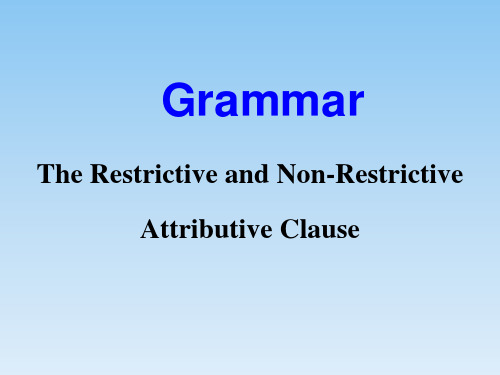
• 关系代词在限制性定语从句中作____ 宾语
时可以省略。
• 关系代词在非限制性定语从句中作宾语时不可
以____ 。 省略
13
3. A middle-aged woman killed her husband, which frightened me very much. 4. A five-year-old boy can speak two foreign languages, which surprises all of us. 大多数定语从句的先行词往往为某一个词 或短语, 而有时非限制性定语从句的先行 词也可为整个主句, 此时非限制性定语从 句常由 _____ which 引导。
14
5.She has married again, which delighted us. 6.Spiders are not insects, as many people think. =(As many people think, spiders are not insects.)
as (译为 __________) “正如……” 引导的非限制性定语从句 的位置比较灵活, 可位于所修饰的句子之后, 句 “这” 或 “这件事” 中或句首; 而由 which (译为 ________________)
16
As “正如、像……一样” 位置可放在主句前面,也可放 在后面。而which引导的非限制性定语从句只能放在主句 之后,且无“正如”之意。
引导的非限制性定语从句一般不位于句首。
15
7.This is the girl whom/who I met in the street. 8.A young man had a new girl friend, whom he wanted to impress. 关系代词 whom 在限制性定语从句中作宾 语时可用 ___ who代替,但在非限制性定语从 whom 。(指人) 句中作宾语时只能用 ______
时可以省略。
• 关系代词在非限制性定语从句中作宾语时不可
以____ 。 省略
13
3. A middle-aged woman killed her husband, which frightened me very much. 4. A five-year-old boy can speak two foreign languages, which surprises all of us. 大多数定语从句的先行词往往为某一个词 或短语, 而有时非限制性定语从句的先行 词也可为整个主句, 此时非限制性定语从 句常由 _____ which 引导。
14
5.She has married again, which delighted us. 6.Spiders are not insects, as many people think. =(As many people think, spiders are not insects.)
as (译为 __________) “正如……” 引导的非限制性定语从句 的位置比较灵活, 可位于所修饰的句子之后, 句 “这” 或 “这件事” 中或句首; 而由 which (译为 ________________)
16
As “正如、像……一样” 位置可放在主句前面,也可放 在后面。而which引导的非限制性定语从句只能放在主句 之后,且无“正如”之意。
引导的非限制性定语从句一般不位于句首。
15
7.This is the girl whom/who I met in the street. 8.A young man had a new girl friend, whom he wanted to impress. 关系代词 whom 在限制性定语从句中作宾 语时可用 ___ who代替,但在非限制性定语从 whom 。(指人) 句中作宾语时只能用 ______
限制性定语从句和非限制性定语从句的区别PPT课件.ppt
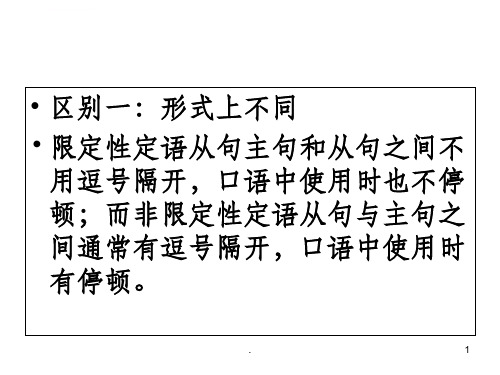
从使用情况来看,闭胸式的使用比较 广泛。 敞开式 盾构之 中有挤 压式盾 构、全 部敞开 式盾构 ,但在 近些年 的城市 地下工 程施工 中已很 少使用 ,在此 不再说 明。
• 区别一:形式上不同
• 限定性定语从句主句和从句之间不 用逗号隔开,口语中使用时也不停 顿;而非限定性定语从句与主句之 间通常有逗号隔开,口语中使用时 有停顿。
• All the books there, which have beautiful pictures in them, were written by him.
那里所有的书都是他写的, 书里附有漂亮的插 图。(说明那里没有除他以外的人写的书)
• All the books there which have
D 4、I don’t like the way _____ he
spoke to me.
A、by that B、what C、by which D、/
.
20
从使用情况来看,闭胸式的使用比较 广泛。 敞开式 盾构之 中有挤 压式盾 构、全 部敞开 式盾构 ,但在 近些年 的城市 地下工 程施工 中已很 少使用 ,在此 不再说 明。
.
2
从使用情况来看,闭胸式的使用比较 广泛。 敞开式 盾构之 中有挤 压式盾 构、全 部敞开 式盾构 ,但在 近些年 的城市 地下工 程施工 中已很 少使用 ,在此 不再说 明。
Discuss the difference
• His brother, who is eighteen years old,
C、which has
D、which has been
.
16
从使用情况来看,闭胸式的使用比较 广泛。 敞开式 盾构之 中有挤 压式盾 构、全 部敞开 式盾构 ,但在 近些年 的城市 地下工 程施工 中已很 少使用 ,在此 不再说 明。
• 区别一:形式上不同
• 限定性定语从句主句和从句之间不 用逗号隔开,口语中使用时也不停 顿;而非限定性定语从句与主句之 间通常有逗号隔开,口语中使用时 有停顿。
• All the books there, which have beautiful pictures in them, were written by him.
那里所有的书都是他写的, 书里附有漂亮的插 图。(说明那里没有除他以外的人写的书)
• All the books there which have
D 4、I don’t like the way _____ he
spoke to me.
A、by that B、what C、by which D、/
.
20
从使用情况来看,闭胸式的使用比较 广泛。 敞开式 盾构之 中有挤 压式盾 构、全 部敞开 式盾构 ,但在 近些年 的城市 地下工 程施工 中已很 少使用 ,在此 不再说 明。
.
2
从使用情况来看,闭胸式的使用比较 广泛。 敞开式 盾构之 中有挤 压式盾 构、全 部敞开 式盾构 ,但在 近些年 的城市 地下工 程施工 中已很 少使用 ,在此 不再说 明。
Discuss the difference
• His brother, who is eighteen years old,
C、which has
D、which has been
.
16
从使用情况来看,闭胸式的使用比较 广泛。 敞开式 盾构之 中有挤 压式盾 构、全 部敞开 式盾构 ,但在 近些年 的城市 地下工 程施工 中已很 少使用 ,在此 不再说 明。
- 1、下载文档前请自行甄别文档内容的完整性,平台不提供额外的编辑、内容补充、找答案等附加服务。
- 2、"仅部分预览"的文档,不可在线预览部分如存在完整性等问题,可反馈申请退款(可完整预览的文档不适用该条件!)。
- 3、如文档侵犯您的权益,请联系客服反馈,我们会尽快为您处理(人工客服工作时间:9:00-18:30)。
came to China yesterday.
2. In those days, she used to go to Mr. Black, with
_w_h_o_m__ she had a wonderful time.
3. I bought a car yesterday, _w_h__ic_h_ cost me a lot.
习
▲ 在 of which / whom 之前可以使 用表达数量或定位的数词或代词
1. I am doing different types of exercises, all of _w_h_i_c_h_ are quite helpful to my health.
2. Many people, some of _w_h_o_m___ are not overweight, are going on diets.
• Teachers who are kind are popular with the students.
• Mr. Wang, who is kind, is popular with
the students.
限制性定语从句 非限制性定语从
省略后主语所指 句省略后意义 仍
就不明确,
然完整,
所以不能省略。 所以可以省略。
Teachers who are kind are popular with the studng, who is kind, is popular with the students.
王老师很受学生欢迎,他很友善。
分析两种定语从句省略后的结果:
4. Xi’an, w__h_i_c_h_ I visited last year, is a nice old city.
5. He will come to see me next July, _w__h_e_n__ he won’t
be so busy.
6. The school, _w__h_e_r_e_ I once studied, was built thirty
• as is known to all • as is often the case 这是常有的事 • as might / could be expected 正如人们所预料的 • as has been said before 正如前面所说的 • as has been mentioned above 正如上面所提到的 • as has been pointed out 正如所指出的 • as can be imagined • as can be seen (from these figures) • as often happens • as will be shown 正如…所示
3. There are 54 students in my class, three of w_h_o_m____ come from US.
要点归纳 “非限定”使用须知
1. 从句中所有的关系词都不可省略
2. 从句通常不能用that引导
3. 在“非限定”中, 指人的关系代词作宾语时, 只 能用宾格whom, 不能用who替换, 也不能省略。
years ago.
课
7. John said he’d been working in the office for an
hour, _w__h_i_c_h_ was true.
堂
8. The manager’s daughter, _w_h__o_s_e_ name is Ann, 练
gave me a patient smile.
1. As we all know, he is a famous
scientist.
2. As is expected, he is a diligent boy.
3. She has the same book as you have.
as 引导非限制性从句,常意为“正如”。 可出现在句首、句中、句末。常见结构有:
我有一位在医院工作的姐姐。 (不只一位姐姐)
2) I have a sister, who works in a hospital.
我有一位姐姐,她在医院工作。 (只有一位姐姐)
注意3: as / which 引导非限定性定语从句的区别
as 和 which 可指代整个主句
as 可放在句中或句首, which 只放在句中 • __A_s__ we know, smoking is harmful to
形式 作用
限制性 定语 从句
无 逗号
非限制 性定语
从句
逗号 隔开
修饰 限定
补充 解释
能否 省略 不能
能
翻译
…的
两个 句子
非限制性定语从句的用法
• 非限制性定语从句是先行词的附加说明, 去掉了也 不会影响主句意思, 它与主句之间通常用逗号分开。
• 引导“非限定”的关系词有:
1. 指人时:who, whom, whose 2. 指物时:which, as
which (可指某个词也可指整个主句,
从句只能位于主句之后)
as (表示正如,可位于主句前或主句后) 3. 指地点时:where = 相应介词 + which 4. 指时间时:when = 相应介词 + which 5. 指原因时:for which (切不可用why)
1. The famous basketball star, _w_h__o_ is an American,
one's health. • The sun heats the earth, _w__h_ic_h_ is very
important to us.
关系代词as在定语从句中指代整件事, 充当句中的主语或者宾语,它经常和 the same, such, as一起搭配使用,共 同构成一个固定词组。
4. 从句不能用why引导, 要用 for which 代替why 5. 从句置于句首时, 不能用which引导; 而要用关
系代词 as 引导 (as可放主句前, 也可放主句后)
注意1:有时同一个限制性从句变为非限 制性从句会改变全句的意思。
1) I have a sister who works in a hospital.
